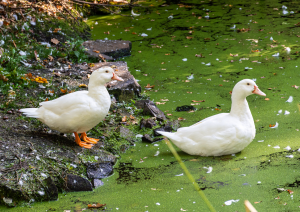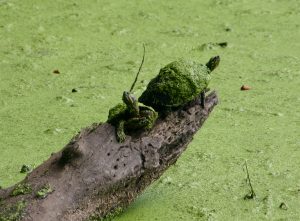
Our first two tiny expeditions of this season kept us firmly on dry land exploring trees and peanuts. Now let’s take a splash into the aquatic world of duckweed, a tiny plant with enormous possibilities.
Duckweeds are some of the smallest and fastest growing flowering plants known on earth. They live on the surface of slow-moving water sources, like ponds and marshes. Duckweed has a very rapid growth cycle, reproducing asexually by repeatedly cloning itself. A single duckweed plant, some as small as the head of a pin, can quickly take over and cover the entire surface of a body of water within a few days.
Although they have long been touted as a nuisance by golf course owners and others trying to maintain a pristine pond or lake, there are actually many amazing applications of duckweeds that can give back and help our planet. Scientists are trying to restore duckweed’s reputation by studying some of the amazing things that it can do—from feeding humans and animals to ridding water sources of chemicals and heavy metals.
Listen to Tiny Expeditions Season 2, Episode 3: “Can a weed save the world?” to learn about the many ways that the tiny aquatic plant can feed, fuel, and clean our planet.
Behind the Scenes

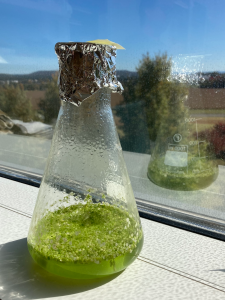
Alex Harkess, PhD (pictured left) studies the weird plants on our planet. And one of his favorite weird plants (although he would never be able to pick just one) is duckweed.
Duckweeds are fascinating plants that are viewed as both nuisances and environmental saviors depending on who you ask. Yes, they can take over entire ponds in a matter of a few days but they also rid water sources of harmful chemicals, feed humans and animals, help eradicate mosquitoes in areas with high levels of mosquito born illness, and even play a role in drug and vaccine development.
After learning all about the amazing tiny plant, we wanted to see some duckweed for ourselves. We walked to the Harkess lab on the HudsonAlpha Institute for Biotechnology campus to checkout their duckweed collection. Laramie Smith (pictured right) is a graduate student at Auburn University in the Crop, Soil and Environmental Science Department. She is doing her graduate research in Dr. Harkess’ lab at HudsonAlpha.
Laramie walked us to the back of the lab and sitting on the sunny windowsill was a flask full of bright green duckweed (pictured bottom left and right). The duckweed looked just like little green orbs floating on the top of the water. It is truly amazing that this small plant can do so much to benefit us and our planet.
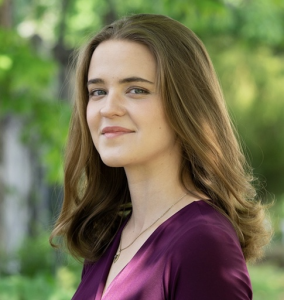
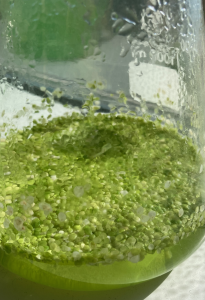
Chris Powell 00:00
Welcome to Season Two of Tiny Expeditions.
Sarah Sharman 00:03
So far this season, we’ve learned about how science is saving our favorite candy bars, and also memorializing iconic trees at college campuses across the country while teaching students about sequencing. Today for episode three, we’re asking the question, can a weed save the world?
Chris Powell 00:21
It may be odd to consider a weed saving the world. But today we’re going to discuss one of the world’s smallest weeds and how it could possibly help clean the environment, feed livestock, help prevent and cure diseases, and also be good for lunch. We’re going to be talking to Dr. Alex Harkess today about this wonderful weed called duckweed.
But first, my name is Chris Powell. I’m going to be your storytelling guide for today.
Sarah Sharman 00:45
And I’m Dr. Sarah Sharman. I’ll be your science advisor for this expedition.
Chris Powell 00:52
So, imagine with me, there’s a yard right in front of you. There are really two types of people in the world. You’re either a person who focuses on the one weed that’s sticking up out of the grass, or you just ignore it and you see like the full yard out in front of you that’s beautiful and green. Sarah, which person are you? Are you the one that’s going to see the weed or are you going to ignore the weed because the rest of the yard looks beautiful?
Sarah Sharman 01:17
I think for me, it depends on which side of my yard I’m looking at. If I’m looking at my yard that’s between the two houses, it’s green, beautiful, and lush. However, if I turn my attention to the other side of my yard near the construction site, there are weeds there that are the size of a human. And I’m not just talking about one, there are tons of huge, tall weeds. And then there are these weeds that my sister calls wildflowers, but we all know they’re weeds.
Chris Powell 01:44
That begs the question then what is the difference between a wildflower and a weed? Can a weed be beautiful?
Alex Harkess 01:51
I think that the word weed is often a derogatory term. And that kind of goes back to some interesting and fun botanical history.
Chris Powell 01:59
That familiar voice you’re hearing right now is from Dr. Alex Harkess, who also joined us on episode one of this season. Dr. Harkess is a faculty investigator at the HudsonAlpha Institute for Biotechnology and is also a joint faculty member at Auburn University.
Sarah Sharman 02:13
Dr. Harkess is an evolutionary biologist. In his lab, they use classical botany and evolutionary biology to look across the tree of life to find cases in which plants have changed the way they reproduce.
Alex Harkess 02:25
Carl Linnaeus, if you know that name, he’s responsible for creating the binomial nomenclature system that is how we classify almost all life on our planet right now. Linnaeus would name weeds after people who disagreed with him. Because they were smelly, or they grew really fast, or they grew in weird places and things like that.
But I don’t really like that definition very much of just a plant growing where we don’t necessarily want it. Not necessarily a botanist by training, but clearly a lover of plants, I like Ralph Waldo Emerson’s definition of a weed much better. He said that a weed is a plant whose virtues have not yet been discovered. And when I think of something like a duckweed, that’s the definition I like to think of.
Chris Powell 02:27
If you’re like me, at least before this episode, I had no idea what duckweed was.
Sarah Sharman 03:25
Duckweed might not be something you know by name, but most of us have probably seen it before.
Alex Harkess 03:30
All of you have definitely seen duckweeds before, they are prolific. We find them almost everywhere on the planet especially in temperate regions. Duckweeds grow pretty much anywhere that there’s slow-moving water, and the temperature is reasonably temperate.
Sarah Sharman 03:47
Just to clarify, duckweeds are tiny aquatic plants that grow on the surface of slow-moving water. Although they’re small, they reproduce quickly and can cover the entire surface of bodies of water. This is why they’re often considered a nuisance.
Alex Harkess 04:02
Yes, duckweeds are a nuisance. They divide so quickly; they colonize new areas. If you talk to a golf course owner, they hate duckweeds because they fill up the ponds, they clog pumps, and they don’t look aesthetically pleasing for that beautiful golf course pond shot that everybody wants.
But on the other hand, I think about a duckweed and see it from a very different perspective. I see a plant that can divide clonally without any human intervention or input at an exponential rate between 12 and 48 hours. I see a plant that can hyper-accumulate nutrients out of wastewater. You can grow duckweeds on water that is filled with agricultural runoff like manure with all sorts of toxins. And not just growing them on water like that, duckweeds are capable of doing things like hyper-accumulation. This means if you grow duckweeds in high nitrogen and phosphorus wastewater which they love, they grow really quickly and they’re able to suck up, kind of like an environmental sponge, a lot of that nitrogen and phosphorus. And this matters because imagine how much fertilizer we’re putting on many of our agricultural fields, and a lot of that ends up in runoff in the waste stream. So, can plants like duckweeds, which love to grow in high nitrogen and high phosphorus water that are able to accumulate nitrogen and phosphorus at high levels, can we use plants like this to reclaim some of the nutrients that we put on our agricultural fields?
Chris Powell 05:43
For a plant as impressive as this you may be asking, why does it have such a simple name?
Alex Harkess 05:49
And the simple answer is kind of the obvious one because ducks love to eat it. Actually, lots of waterfowl, fish, all feed on duckweeds, right? They cover the tops of ponds and slow-moving water, and they act as this really amazing food source for many, many organisms since duckweeds can grow almost everywhere on the planet. Of course, one of the obvious questions is ‘Can people eat them?’ Actually, we find that in some parts of Southeastern Asia, like Thailand, Laos, and Burma, one species of Wolffia, Wolffia globosa, which is a duckweed species, is eaten right out of the water. It’s called, and I’ll butcher this because I don’t know the language, but in Thai they’re called eggs of the water, or keinem in Thai language because they look like tiny green eggs dotted all across the pond.
Chris Powell 06:44
After hearing about this wonderful little plant, Sarah and I decided we need to see this. So, we went to the Harkess lab at the HudsonAlpha Institute for Biotechnology.
Chris Powell 06:53
Let’s head into the lab. So there’s something here in the window, what are we looking at here?
Laramie Aközbek (nee Smith) 07:08
So we’re actually looking at a flask with a bunch of duckweeds growing inside of it. And these guys are extremely low maintenance, you can just throw a single one in one of these flasks and just give it a little bit of time. And then there’ll be a little green wonderland.
Chris Powell 07:24
Wow, so this is covered. How long has that been? How, how long did it take to get from one duckweed to that?
Laramie Aközbek (nee Smith) 07:30
Oh, goodness, I don’t know the answer to that question. But I know that it’s very, very quick. It’s one of the fastest dividing plants in the world. And so it probably wouldn’t take that long for it to completely cover the flask from one single little duckweed bud because it clonally propagates it buds off from itself.
Chris Powell 07:47
So, what’s the end goal with this particular container of duckweed? What are we going to do with this?
Laramie Aközbek (nee Smith) 07:53
This one is for us to enjoy. But there are a lot of applications for duckweeds, from bioremediation to potential applications to the food industry. I’m a forager, so actually, this is a really interesting plant for me. It’s one that you can actually just pick up and eat just raw, you don’t even have to cook it, which is rare for a wild food. So, I particularly love this plant for that reason. It’s just it has so many applications, but this one is just for the lab to sit and enjoy and remind ourselves that duckweeds are cool.
Chris Powell 08:22
Well, you answered my question. I was going to ask if you ever got the urge to come over and just grab some and eat it.
Sarah Sharman 08:26
What does it taste like?
Laramie Akozbek (nee Smith) 08:28
Oh, it’s just like green. But it is it’s a very high protein content plant, which is actually really helpful. If you’re in a survival situation and you find some duckweeds, just make sure that the water you’re getting it from is also clean. So yes, because they are, they accumulate all kinds of things from the environment around them.
Chris Powell 08:50
So, tell me scale of one to 10 how excited you get over duckweed.
Laramie Akozbek (nee Smith) 08:56
Very excited. I would put it at a strong 9.5 Just because I’m not Alex, Alex takes the gold.
Chris Powell 09:04
Does it like give you heartburn when you hear people referring to it just as a weed?
Laramie Akozbek (nee Smith) 09:11
Yes, yes, absolutely. It’s called, I think, a green lentil or a water lentil. So, I think that’s far more appropriate. Something more true to what it can be used for.
Chris Powell 09:22
You know, now that you say that, quite fitting it.
Laramie Akozbek (nee Smith) 09:25
It looks like a lentil. Yes. Yes.
Sarah Sharman 09:28
Although it might be a while before you can skip some duckweed out of a tank at your local grocery store. In the meantime, it makes great feed for livestock.
Alex Harkess 09:38
What if we could use or rethink the way that we are feeding animals in animal agriculture? A duckweed can be up to 40% protein by dry mass, that’s an amazing amount of protein that is just sitting there. And we can do something with it.
Chris Powell 09:55
So, if duckweed is going to feed livestock animals, and eventually feed humans, we’re going to need a lot of it. Thankfully, duckweed is very good about reproducing itself.
Alex Harkess 10:07
Of those 36 duckweed species that exist around the planet, maybe about half of them seem to produce flowers. But weirdly, we never really get seeds. And these flowers are really, really tiny. It’s not like, you know, a typical flower that you would see where you can, you know, see the male parts and the female parts and get a seed or something like that. They’re really, really minute. And so duckweeds primarily reproduce clonally or asexually meaning that they basically just divide. And so in a matter of 12 to 48 hours, depending on the species, these plants can make perfect clones of themselves. And they can divide at exponential rates so that once one plant buds off, forms a clone of itself, it can also then begin producing clonal offspring itself. So starting from just one little tiny duckweed in a pond, very quickly, you can imagine the entire pond can be covered in hundreds of 1000s or millions of these clonal duckweeds.
Chris Powell 11:07
So, duckweed can help us when it comes to feeding livestock. But the benefits of duckweed don’t stop there. They can also help us with other issues like the runoff of fertilizer. Farmers are constantly having to deal with what can be an environmental hazard when this fertilizer goes into settling ponds, where duckweed lives. Duckweed can actually help us with that. Dr. Harkess introduced us to the term of hyperaccumulation earlier. Dr. Sharman, can you shed a little bit more light on what hyperaccumulation is, and how it helps us out?
Sarah Sharman 11:41
Duckweed is just like a sponge. It can soak up heavy metals and other chemicals from water supplies like ponds. And when you imagine a sponge, once you’ve soaked up water, it can be squeezed out into another container. So, what if we could take the chemicals out of the duckweed and repurpose them and use them for fertilizer?
Alex Harkess 12:02
Again, these are not new ideas, which is what I really love. There’s that classic saying, if you want a new idea, read an old book. People have thought about these clonal duckweeds for hundreds of years and how fascinating their biology is, and how we could use that interesting biology to improve agriculture. For instance, if you’re growing duckweeds on high nitrogen, high phosphorus kind of wastewater, and they suck up a bunch of that nitrate and phosphate, then yes, you could grind up those plants and use it almost like a renewable fertilizer. And I’m certainly not the first person to think about how amazing duckweeds are. Actually, some biotechnology companies have taken an interest in duckweeds as well. One really great example is Biolex Therapeutics. They were founded sometime in the 1990s. But they started to use duckweeds to express proteins, monoclonal antibodies, glycosylated proteins, and even made anti-cancer therapeutics like interferon. And since these plants can grow with not that much space, and they can be stackable, you know, like in shipping containers that you can put lights in between them and make these huge wafers of plants you can grow a ton of duckweeds. And again, since they divide and grow so quickly, you don’t need all that much human input to grow them, you kind of just put one in a dish and let it go as long as the conditions are right. So they’re really excellent kind of as a platform for producing molecules. This could have a place as we think about the future of vaccines potentially.
Chris Powell 13:44
A weed is a weed is a weed unless that weed is duckweed. Duckweed is such a very small plant. But as Dr. Harkess has shown us, it has so much possibility to help not only with agriculture but even for human health and consumption. So next time you’re at a pond, make sure you watch out for that little weed that sitting on top and ask yourself, is that really a weed?
Alex Harkess 14:10
It’s difficult for me to think of it as a pest or a nuisance because in my mind thinking from an evolutionary background, I think that’s one of the most successful plants on the planet. It’s able to divide incredibly quickly, it’s able to colonize new areas. Duckweeds are actually so easy to move around different parts of the country because ducks eat duckweeds and actually a duckweed can survive whole through the entire digestive tract of a duck. And you can imagine that a duck will eat some duckweeds out of a pond and then fly far away and you can kind of guess the rest. But these plants are so impressive from an evolutionary standpoint in my eyes. There are several hundred thousand species of plants on the planet today, and yet most of modern agriculture focuses on just a small handful of them. There is immense power in thinking about the other plants on the planet, the weeds, if you want to call them that, and how they’ve evolved incredible adaptations that well can change them from a weed into a crop. I think duckweeds fall into that category. If we just shift our thinking, to not perceive them as something totally negative, and something that needs to be destroyed, we can find better uses for them. We can find ways to take advantage of all these evolutionary adaptations that they have gained. Over time, we can find ways to farm duckweeds.
Sarah Sharman 15:42
Thank you for joining us for this tiny expedition into the world of duckweed, a tiny plant with enormous possibilities.
Chris Powell 15:49
In the coming weeks, we’ll get a behind-the-scenes look at the science of craft brewing, and then we’re off to space.
Sarah Sharman 15:56
Tiny expeditions is a podcast about genetics, DNA and inheritance from the HudsonAlpha Institute for Biotechnology. We’re a nonprofit research institution in Huntsville, Alabama.
Chris Powell 16:08
We’ve got a campus full of scientists doing public research alongside of companies developing products and services. And all of this is with the aim to translate genomic discoveries into real-world applications that make for a healthier, more sustainable world. That includes everything from cancer research to agriculture for a changing climate.
Sarah Sharman 16:27
If you find this podcast helpful, do us a favor and leave us a review on iTunes or wherever you’re listening to this. Also tell someone that you listened to this interesting little story about genetics. Knowledge is better when you share it. Thanks for joining us.






